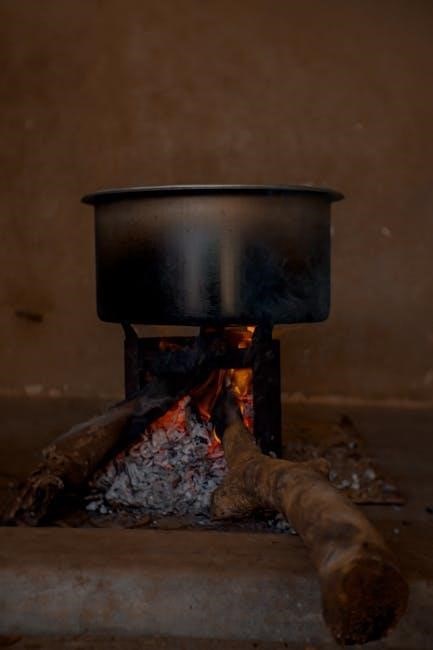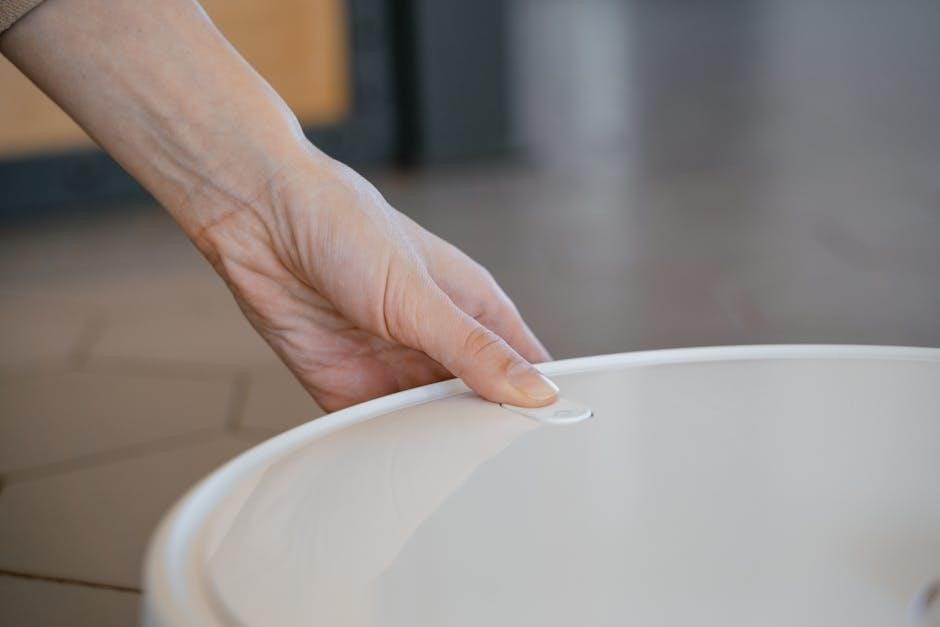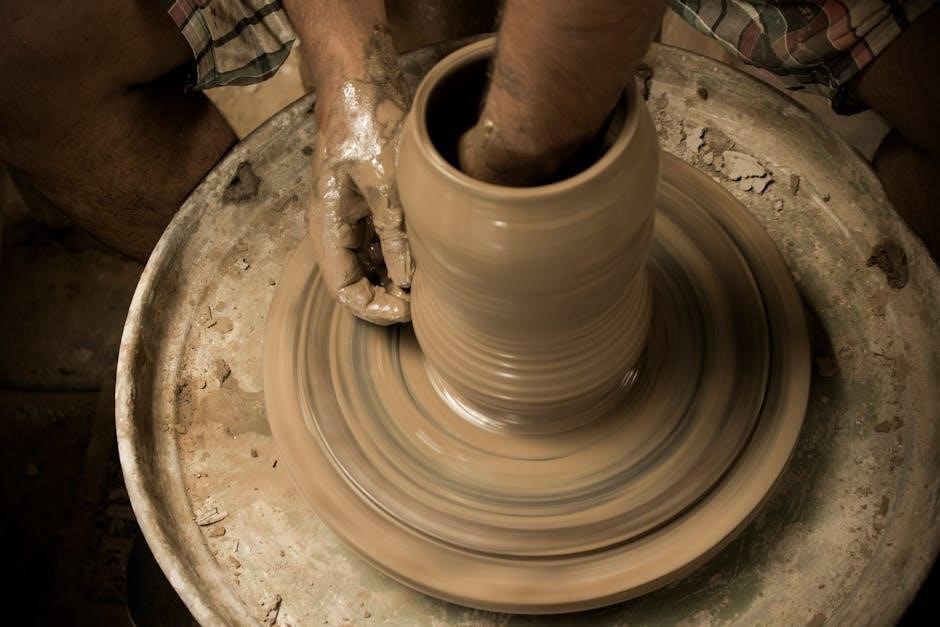Crock-Pot vs․ Instant Pot: A Detailed Comparison
The Crock-Pot and Instant Pot are both popular kitchen appliances designed for convenient meal preparation․ While both simplify cooking, they operate differently․ The Crock-Pot excels at slow cooking, while the Instant Pot offers pressure cooking and multiple functions, leading to varied cooking times and outcomes․
What is a Crock-Pot?
A Crock-Pot is a type of slow cooker, an electric countertop appliance designed to simmer food at a low temperature for extended periods․ Introduced in the 1940s, it has become a kitchen staple for its simplicity and ability to create flavorful, one-pot meals with minimal effort․ Crock-Pots typically have just a few settings, such as low, high, and warm, making them incredibly user-friendly․
The appliance consists of a ceramic or porcelain pot that sits inside a heated base․ This design allows for even heat distribution, ensuring that food cooks gently and evenly over several hours․ This extended cooking process is perfect for tenderizing tougher cuts of meat and allowing flavors to meld together beautifully, resulting in delicious, home-cooked meals with very little active cooking time․
What is an Instant Pot?
An Instant Pot is a multi-functional electric pressure cooker, often referred to as a multicooker, designed to perform various cooking tasks in a single appliance․ Beyond pressure cooking, it can also function as a slow cooker, rice cooker, steamer, sauté pan, yogurt maker, and more․ This versatility makes it a popular choice for home cooks seeking to simplify meal preparation and reduce the number of kitchen gadgets․
Instant Pots feature a user-friendly interface with pre-set programs and customizable settings, allowing for precise control over cooking time and temperature․ The pressure cooking function significantly reduces cooking time compared to traditional methods, while other functions offer flexibility for different recipes and cooking styles․ Safety features are built-in to ensure safe pressure release and prevent accidents, making it a reliable and convenient kitchen tool․

Key Differences Between Crock-Pots and Instant Pots
The primary differences between Crock-Pots and Instant Pots lie in cooking speed, functionality, and versatility․ Crock-Pots are designed for slow cooking, while Instant Pots offer faster cooking times through pressure cooking and additional functions․
Cooking Speed
One of the most significant differences between Crock-Pots and Instant Pots is cooking speed․ Crock-Pots, also known as slow cookers, are designed to cook food at low temperatures over extended periods, typically ranging from 4 to 8 hours or even longer․ This slow cooking process allows flavors to meld together, resulting in tender and flavorful dishes․
In contrast, Instant Pots utilize pressure cooking technology, which significantly reduces cooking times․ They can cook food up to 70% faster than traditional cooking methods․ For example, a recipe that takes 8 hours in a Crock-Pot might be ready in just 25 to 30 minutes in an Instant Pot; This speed advantage makes Instant Pots a popular choice for busy individuals who want to enjoy home-cooked meals without spending hours in the kitchen․
Functionality
Crock-Pots primarily function as slow cookers, offering a simple and straightforward cooking process․ You add ingredients, set the temperature, and let it cook for hours․ Some models offer basic settings like “low,” “high,” and “warm․”
Instant Pots, on the other hand, are multi-cookers with a wide range of functions․ Besides slow cooking, they can pressure cook, sauté, steam, make yogurt, and even act as rice cookers․ This versatility allows you to perform various cooking tasks with a single appliance, reducing the need for multiple gadgets in your kitchen․ The Instant Pot’s ability to perform different functions makes it a more versatile appliance compared to the single-purpose Crock-Pot․ Many Instant Pots come with pre-set programs for different types of food, simplifying the cooking process;
Versatility
The Instant Pot stands out with its incredible versatility, functioning as multiple appliances in one․ It serves as a pressure cooker, slow cooker, rice cooker, steamer, yogurt maker, and more․ This multi-functionality makes it ideal for various cooking styles and recipes․ You can sauté ingredients directly in the pot before pressure cooking, adding depth of flavor․
Crock-Pots, while excellent at slow cooking, have limited versatility․ Their primary function is to cook food slowly at a low temperature․ This makes them suitable for specific types of recipes like stews, roasts, and pulled meats․ While you can adapt some recipes for a Crock-Pot, it lacks the range of functions offered by the Instant Pot․ Therefore, the Instant Pot offers greater versatility․

Advantages of Using a Crock-Pot
Crock-Pots offer simplicity and ease of use, requiring minimal effort․ They excel at slow cooking, extracting rich flavors over extended periods․ Their reliability makes them perfect for classic slow-cooked dishes, providing consistent results with minimal monitoring․
Simplicity and Ease of Use
Crock-Pots are renowned for their straightforward operation, making them exceptionally user-friendly, even for novice cooks․ The design is simple: add your ingredients, select the heat setting (usually low or high), and let it cook․ There are no complex programs or intricate buttons to navigate, removing any intimidation factor associated with more advanced appliances․
This simplicity extends to cleanup as well․ Typically, the insert is removable and easy to wash․ The straightforward nature of the Crock-Pot makes it an ideal choice for those who value convenience and a hassle-free cooking experience․ Its uncomplicated design ensures anyone can create delicious, slow-cooked meals with minimal effort․
Reliability for Slow Cooking
Crock-Pots excel in consistent, low-temperature cooking over extended periods, making them highly reliable for traditional slow-cooking recipes․ Their primary function is to gently simmer food for hours, which allows flavors to meld and tough cuts of meat to become tender․ This consistent heat distribution ensures even cooking, preventing hot spots and scorching․
While Instant Pots offer a slow-cooking function, Crock-Pots are often preferred for recipes requiring extended cook times and consistent low heat․ Many users find that dedicated slow cookers provide more reliable results for dishes like stews and pot roasts, where the extended cooking process is crucial for optimal flavor and texture development․
Advantages of Using an Instant Pot
Instant Pots offer faster cooking times, multi-functionality (pressure cooking, slow cooking, sautéing), and user-friendly interfaces․ These features make them versatile for various recipes and appealing to those seeking quick and convenient meal preparation options in the kitchen․
Faster Cooking Times
One of the most significant advantages of the Instant Pot over the Crock-Pot is its significantly faster cooking times․ Utilizing pressure cooking technology, the Instant Pot can cook food up to 70% faster than traditional cooking methods or slow cookers․ This is particularly beneficial for individuals with busy lifestyles who want to enjoy home-cooked meals without spending hours in the kitchen․ Meats that would typically require several hours in a slow cooker can be ready in under an hour in an Instant Pot․ This speed advantage also extends to other dishes like soups, stews, and even rice, making the Instant Pot a time-saving appliance for quick and efficient meal preparation․
Multi-Functionality
The Instant Pot distinguishes itself from the Crock-Pot with its impressive multi-functionality․ While the Crock-Pot primarily focuses on slow cooking, the Instant Pot combines several appliances into one․ It serves as a pressure cooker, slow cooker, rice cooker, steamer, sauté pan, yogurt maker, and warmer․ This versatility allows users to perform a wide range of cooking tasks with a single appliance, reducing clutter and saving space in the kitchen․ The ability to sauté ingredients directly in the Instant Pot before pressure cooking or slow cooking adds another layer of convenience and flavor development, making it a versatile tool for various recipes․
User-Friendly Interface
One of the standout features of the Instant Pot is its user-friendly interface, designed to make cooking accessible even for beginners․ The control panel typically features pre-programmed settings for common cooking tasks, such as pressure cooking, slow cooking, rice cooking, and more․ These presets simplify the cooking process by automatically setting the appropriate time and pressure levels․ Additionally, the Instant Pot often includes a digital display that provides clear feedback on the cooking progress and allows users to easily adjust settings as needed․ The intuitive design minimizes the learning curve and empowers users to confidently experiment with different recipes․

Can an Instant Pot Replace a Slow Cooker?
Yes, an Instant Pot can replace a slow cooker, offering similar functionality alongside faster cooking options․ However, be aware that the final results might exhibit slight differences in texture and flavor compared to a traditional slow-cooked meal․
Potential Differences in Results
While an Instant Pot can mimic slow cooking, expect subtle variations in the final dish․ A Crock-Pot’s gradual heating can result in flavors melding more deeply․ Conversely, the Instant Pot’s faster process might not achieve the same level of flavor infusion, potentially leaving some ingredients tasting distinct rather than harmonized․
Furthermore, texture can differ; slow cookers often produce more tender results, especially with tougher cuts of meat, due to extended low-temperature cooking․ The Instant Pot, although capable, may require adjustments to timing and liquid ratios to replicate the same level of tenderness․ Be sure to consult reliable resources․
The cooking mechanism of the Instant Pot differs from a slow cooker, possibly leading to varied cooking times․
Converting Recipes: Slow Cooker to Instant Pot
Adapting slow cooker recipes for the Instant Pot requires adjusting cooking times significantly․ Due to pressure cooking’s speed, reduce the original slow cooker time drastically․ Consult conversion charts for guidelines to ensure optimal results and avoid overcooking your meal․
Time Conversion Guidelines
When converting recipes from a slow cooker to an Instant Pot, understanding time adjustments is crucial for success․ A general rule of thumb is that if a recipe requires 8 hours on low in a slow cooker, it typically translates to around 25-30 minutes under high pressure in an Instant Pot․ For recipes that call for 4 hours on high in a slow cooker, reduce the Instant Pot pressure cooking time to about 15 minutes․ Remember, these are estimations, and the specific time may vary based on the ingredients and volume of the recipe․ Always consult reliable conversion charts and consider conducting a test run to fine-tune the cooking time for your specific recipe․ Factors like meat density and liquid content can influence the final result, so careful observation is key to achieving the desired tenderness and flavor․
Energy Consumption: Crock-Pot vs․ Instant Pot
When comparing energy usage, Crock-Pots generally consume less electricity than Instant Pots due to their lower wattage and longer cooking times․ A slow cooker operates at a consistent low temperature for several hours, while an Instant Pot uses higher wattage for a shorter duration to reach pressure․ However, the total energy consumption can be comparable depending on the specific model and cooking duration․ Some studies suggest that using a slow cooker can result in lower electricity bills compared to oven cooking․ While Instant Pot owners claim even less energy consumption, this is not proven․ Factors like insulation, cooking frequency, and local electricity rates influence the overall cost․ Consider these aspects when selecting an appliance to minimize your energy footprint and save money․ Ultimately, both appliances offer energy-efficient alternatives to conventional cooking methods․

Specific Cooking Tasks: Which Appliance Excels?
The choice between a Crock-Pot and an Instant Pot depends on the specific dish․ Slow cookers excel at tenderizing tough cuts of meat, while Instant Pots are ideal for faster cooking and tasks like rice preparation or steaming vegetables․
Beef Stew and Pot Roast
When it comes to beef stew and pot roast, both the Crock-Pot and Instant Pot can deliver delicious results, but through different approaches․ The Crock-Pot’s slow, consistent heat is excellent for breaking down tough cuts of beef over several hours, resulting in exceptionally tender and flavorful meat․ The long cooking time allows the flavors to meld together, creating a rich and hearty stew or pot roast․
The Instant Pot, on the other hand, utilizes pressure cooking to achieve a similar level of tenderness in a fraction of the time․ While it may not replicate the exact depth of flavor achieved through slow cooking, the Instant Pot offers a convenient and faster alternative for busy weeknights․ The choice depends on your time constraints and desired flavor profile․ Some argue the Crock-Pot yields a superior result for these dishes due to its gradual cooking process;

